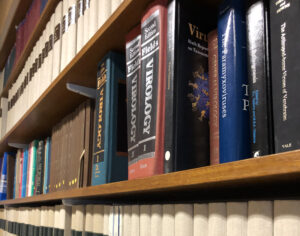Protein Interaction

Publications
2021
The Arp1/11 minifilament of dynactin primes the endosomal Arp2/3 complex.
Fokin AI, David V, Oguievetskaia K, Derivery E, Stone CE, Cao L, Rocques N, Molinie N, Henriot V, Aumont-Nicaise M, Hinckelmann MV, Saudou F, Le Clainche C, Carter AP, Romet-Lemonne G, Gautreau AM. Sci Adv. 2021 Jan 13;7(3):eabd5956. doi: 10.1126/sciadv.abd5956. Print 2021 Jan. PMID: 33523880 Free PMC article.
Characterization of the first tetrameric transcription factor of the GntR superfamily with allosteric regulation from the bacterial pathogen Agrobacterium fabrum.
Vigouroux A, Meyer T, Naretto A, Legrand P, Aumont-Nicaise M, Di Cicco A, Renoud S, Doré J, Lévy D, Vial L, Lavire C, Moréra S. Nucleic Acids Res. 2021 Jan 11;49(1):529-546. doi: 10.1093/nar/gkaa1181. PMID: 33313837 Free PMC article.
Measurements of Protein-DNA Complexes Interactions by Isothermal Titration Calorimetry (ITC) and Microscale Thermophoresis (MST).
Gontier A, Varela PF, Nemoz C, Ropars V, Aumont-Nicaise M, Desmadril M, Charbonnier JB. Methods Mol Biol. 2021;2247:125-143. doi: 10.1007/978-1-0716-1126-5_7. PMID: 33301115
2020
Characterization of the first tetrameric transcription factor of the GntR superfamily with allosteric regulation from the bacterial pathogen Agrobacterium fabrum. Vigouroux A, Meyer T, Naretto A, Legrand P, Aumont-Nicaise M, Di Cicco A, Renoud S, Doré J, Lévy D, Vial L, Lavire C, Moréra S. Nucleic Acids Res. 2020 Dec 11:gkaa1181. doi: 10.1093/nar/gkaa1181. Online ahead of print. PMID: 33313837
Bioinspired Hybrid Fluorescent Ligands for the FK1 Domain of FKBP52. de la Sierra-Gallay IL, Belnou M, Chambraud B, Genet M, van Tilbeurgh H, Aumont-Nicaise M, Desmadril M, Baulieu EE, Jacquot Y, Byrne C. J Med Chem. 2020 Sep 24;63(18):10330-10338. doi: 10.1021/acs.jmedchem.0c00825. Epub 2020 Sep 15. PMID: 32866001
Molecular dissection of pheromone selectivity in the competence signaling system ComRS of streptococci. Ledesma-Garcia L, Thuillier J, Guzman-Espinola A, Ensinck I, Li de la Sierra-Gallay I, Lazar N, Aumont-Nicaise M, Mignolet J, Soumillion P, Nessler S, Hols P. Proc Natl Acad Sci U S A. 2020 Apr 7;117(14):7745-7754. doi: 10.1073/pnas.1916085117. Epub 2020 Mar 20. PMID: 32198205 Free PMC article.
Import pathways of the mannityl-opines into the bacterial pathogen Agrobacterium tumefaciens: structural, affinity and in vivo approaches. Vigouroux A, Doré J, Marty L, Aumont-Nicaise M, Legrand P, Dessaux Y, Vial L, Moréra S. Biochem J. 2020 Feb 14;477(3):615-628. doi: 10.1042/BCJ20190886.
2019
Identification of the periplasmic DNA receptor for natural transformation of Helicobacter pylori. Damke PP, Di Guilmi AM, Fernández Varela P, Velours C, Marsin S, Veaute X, achouri M, Gunjal GV, Rao DN, Charbonnier JB, Radicella JP. Nat Commun. 2019 Nov 25;10(1):5357. doi: 10.1038/s41467-019-13352-6.
Structural characterization of the RH1-LZI tandem of JIP3/4 highlights RH1 domains as a cytoskeletal motor-binding motif. Vilela F, Velours C, Chenon M, Aumont-Nicaise M, Campanacci V, Thureau A, Pylypenko O, Andreani J, Llinas P, Ménétrey J. Sci Rep. 2019 Nov 5;9(1):16036. doi: 10.1038/s41598-019-52537-3.
A unique ferrous iron binding mode is associated with large conformational changes for the transport protein FpvC of Pseudomonas aeruginosa. Vigouroux A, Aumont-Nicaise M, Boussac A, Marty L, Lo Bello L, Legrand P, Brillet K, Schalk IJ, Moréra S. FEBS J. 2019 Jul 18. doi: 10.1111/febs.15004. [Epub ahead of print]
Insight into microtubule nucleation from tubulin-capping proteins. Campanacci V, Urvoas A, Cantos-Fernandes S, Aumont-Nicaise M, Arteni AA, Velours C, Valerio-Lepiniec M, Dreier B, Plückthun A, Pilon A, Poüs C, Minard P, Gigant B. Proc Natl Acad Sci U S A. 2019 May 14;116(20):9859-9864. doi: 10.1073/pnas.1813559116. Epub 2019 Apr 29.
Biophysical and structural characterization of a zinc-responsive repressor of the MarR superfamily. Varela PF, Velours C, Aumont-Niçaise M, Pineau B, Legrand P, Poquet I. PLoS One. 2019 Feb 12;14(2):e0210123. doi: 10.1371/journal.pone.0210123. eCollection 2019.
Ligand-induced conformational switch in an artificial bidomain protein scaffold. Léger C, Di Meo T, Aumont-Nicaise M, Velours C, Durand D, Li de la Sierra-Gallay I, van Tilbeurgh H, Hildebrandt N, Desmadril M, Urvoas A, Valerio-Lepiniec M, Minard P. Sci Rep. 2019 Feb 4;9(1):1178. doi: 10.1038/s41598-018-37256-5.
Molecular basis for transfer RNA recognition by the double-stranded RNA-binding domain of human dihydrouridine synthase 2. Bou-Nader C, Barraud P, Pecqueur L, Pérez J, Velours C, Shepard W, Fontecave M, Tisné C, Hamdane D. Nucleic Acids Res. 2019 Apr 8;47(6):3117-3126. doi: 10.1093/nar/gky1302.
Selection and Characterization of Artificial Proteins Targeting the Tubulin α Subunit. Campanacci V, Urvoas A, Consolati T, Cantos-Fernandes S, Aumont-Nicaise M, Valerio-Lepiniec M, Surrey T, Minard P, Gigant B. Structure. 2019 Mar 5;27(3):497-506.e4. doi: 10.1016/j.str.2018.12.001. Epub 2019 Jan 17.
Structural basis for two efficient modes of agropinic acid opine import into the bacterial pathogen Agrobacterium tumefaciens. Marty L, Vigouroux A, Aumont-Nicaise M, Pelissier F, Meyer T, Lavire C, Dessaux Y, Moréra S. Biochem J. 2019 Jan 15;476(1):165-178. doi: 10.1042/BCJ20180861.
